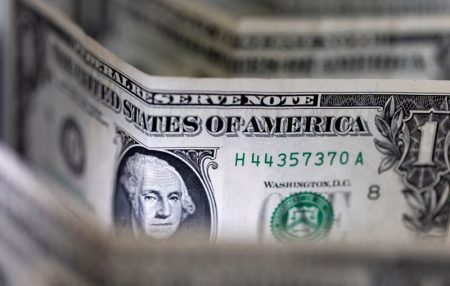By Saqib Iqbal Ahmed
NEW YORK (Reuters) -The dollar rose against the euro on Friday but was on track for its fifth straight weekly loss against the common currency, after slower U.S. consumer spending growth boosted hopes the Federal Reserve would be less aggressive in hiking interest rates.
U.S. consumer spending rose moderately in February after surging the prior month, and while inflation showed signs of cooling it remained elevated, which could prompt the Fed to raise interest rates once more this year.
Earlier in the session, data showed euro zone inflation dropped by the most on record in March, but core price pressures, which exclude food and energy, accelerated, maintaining pressure on the European Central Bank to keep raising rates.
“Slower (U.S.) consumer spending and cooler inflation is consistent with the view that the Fed is almost down,” said Joe Manimbo, senior market analyst at Convera in Washington.
“(In Europe) core inflation accelerated to new record highs. That’s consistent with the ECB raising rates more than the Fed as we go through the balance of the year.”
The euro was 0.48% lower at $1.0852 after the data. The European currency was up 0.8% in its fifth straight week of gains against the greenback, the longest such streak since August 2020.
The Fed is seen as about as likely to raise its benchmark overnight interest rate in May as not. But even if it does, it is expected to reverse course quickly and end the year with rates lower than it began, according to futures contracts tied to the U.S. central bank’s policy rate.
“My gut feeling is that the Fed will go for another 25 basis points in May, and that will be it … but the ECB I can see hiking aggressively still into the summer,” Stuart Cole, head macro economist at Equiti Capital, said.
“You can potentially see that being positive for from the interest rate perspective,” he said.
Next week, central bank meetings loom in Australia and New Zealand. Markets have priced in a pause for Australia and a step down in pace to a 25 basis point increase for New Zealand.
The fell 0.45% and the was down 0.1%, after data showed China’s manufacturing activity expanded at a slower pace in March, raising doubts about the strength of a post-COVID factory recovery with weaker global demand and a property market downturn.
Sterling weakened 0.4% on Friday to $1.2337, as a murky economic outlook overshadowed data showing Britain avoided a recession in the final months of 2022.
In cryptocurrencies, bitcoin was 1.1% higher at $28,340. The digital currency came under pressure recently as investors worried over cryptocurrency exchange Binance and Chief Executive Changpeng Zhou being sued by the Commodity Futures Trading Commission(CFTC) over regulatory violations.
Read the full article here














